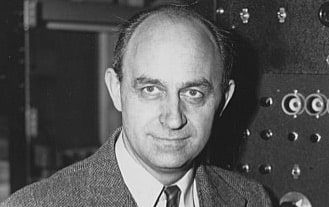
Enrico Fermi was born on September 29, 1901 into a middle-class family in Rome, Italy. His father, Alfredo, was an administrator in the local government, and his mother was a schoolteacher. Enrico showed an early aptitude for mathematics and science and was particularly interested in physics. When Enrico was 13 years old, he met Adolfo Amidei, a workmate of his father who accompanied Alfredo on their walk home from work each day. On discovering Enrico’s interest in mathematics, Adolfo gave him a book on projective geometry. When Fermi returned the book within two months, having solved all the problems presented in the last chapter, Adolfo proclaimed Enrico a geometric prodigy and showered him with a variety of books on mathematics and physics. In 1918, Enrico entered the University of Pisa to study physics, earning his doctorate in 1922 with a thesis on the images obtained by the diffraction of X-rays.
Fermi’s work in the 1920s and 1930s focused on quantum mechanics and statistical mechanics. He made significant contributions to the theory of beta decay and the statistics of particles obeying the Pauli exclusion principle. In 1934, Fermi introduced the concept of the Fermi-Dirac statistics, which describe the behavior of particles known as fermions, such as electrons and protons. Fermions (named in honor of Fermi) are subatomic particles with odd half-integral angular momentum (spin 1/2, 3/2). As experimental physics progressed, new fermions proliferated like rabbits, and when a young physicist asked Fermi the name of a particular fermion, the aging physicist responded, “Young man, if I could remember the names of these particles, I would have been a botanist.”
Enrico Fermi is perhaps best known for his experiments with slow neutrons, that led to the discovery of nuclear reactions and the creation of new radioactive isotopes. Fermi also conducted pioneering research on nuclear reactions and was awarded the Nobel Prize in Physics in 1938 for his work on the artificial transmutation of elements using neutron bombardment.
In 1938, Fermi, observing the rising tide of fascism in Italy, emigrated to the United States, and joined the faculty at Columbia University in New York. During World War II, he played a key role in the Manhattan Project, dedicated to the development of the world’s first atomic bomb. On December 2, 1942, at the University of Chicago, he led his team to the production of the first controlled nuclear chain reaction. This achievement marked a significant step toward the development of atomic weapons and the eventual use of the nuclear bomb.
After the war, Fermi continued his research in nuclear physics and high-energy physics. He became a professor at the University of Chicago, where he remained until his death from stomach cancer on November 28, 1954. Fermi’s work laid the foundation for modern particle physics, and his contributions to nuclear physics and the Manhattan Project had a profound impact on the course of history. He is remembered as one of the most influential physicists of the 20th century, and his name is associated with numerous scientific principles, concepts, and discoveries in the fields of nuclear physics, quantum mechanics, and statistical mechanics.
